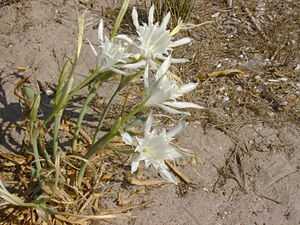Pancratium maritimum
| Pancratium maritimum | |
|---|---|
 | |
| Scientific classification | |
| Kingdom: | Plantae |
| Clade: | Angiosperms |
| Clade: | Monocots |
| Order: | Asparagales |
| Family: | Amaryllidaceae |
| Subfamily: | Amaryllidoideae |
| Genus: | Pancratium |
| Species: | P. maritimum |
| Binomial name | |
| Pancratium maritimum L. | |
| Synonyms | |
|
P. angustifolium M. Roem. | |
Pancratium maritimum, or sea daffodil, is a species of bulbous plant native to the Mediterranean region and south-western Europe. That plant can also be seen on the south Bulgarian and north Turkish coasts of Black Sea, where it is threatened with extinction. It grows on coastal sands or just above the high tide mark. Other vernacular names are Sand Daffodil, Sand Lily and the Lily of St. Nicholas. The Latin maritimum means "of the sea".[1]
Description
P. maritimum is a bulbous perennial with a long neck and glaucous, broadly linear leaves, evergreen, but the leaves often die back during hot summers. Scape to 40 centimetres (16 in). Flowers 3–15 in an umbel, up to 15 cm (6 in) long, white. Corona two-thirds as long as the tepals. The flowers have a pleasing, exotic and very subtle lily scent, which only becomes apparent during still, windless summer nights that allow the delicate fragrance to become perceptible. Flowering is from August to October.

Ecology
The plant is pollinated by a hawk-moth named Agrius convolvuli. These insects visits the flower when the speed of the wind is under 2 metres per second (6.6 ft/s). When it's higher than that the moths does not visit the Pancratium plant. Even if the species is pollinated in an artificial way during windy weather the pollination is not effective. Another specific of the sand lily is that it is not receptive to its own pollen and the plant can recognize it. This flower can be only cross-pollinated.
Easily grown but requires a very sunny position and a very well drained, sandy soil. Needs hot summers to induce flowering and is often a shy bloomer in cooler climates. Hardy to USDA zone 8. Tolerates temperatures down to about −5 °C (23 °F). Propagation by seeds or division after flowering. Seedlings may flower in their third or fourth year.
Name
The Hebrew name for the flower is חבצלת החוף (khavatselet ha-Khof), closely related to the rose of Sharon (khavatselet ha-Sharon – חבצלת השרון) mentioned in the Song of Solomon. It is commonly assumed by most people in Israel that, the Sharon plain being on the coast of the Mediterranean Sea, the biblical passage refers to this flower.
Chemistry
4'-Hydroxy-5,7-dimethoxy-8-methylflavan is a flavan found in P. maritimum.[2]
References
- ↑ Jaeger, Edmund Carroll (1959). A source-book of biological names and terms. Springfield, Ill: Thomas. ISBN 0-398-06179-3.
- ↑ A. A. Ali, M. A. Makboul, A. A. Attia & D. T. Ali (1990). "Chromones and flavans from Pancratium maritimum". Phytochemistry 29 (2): 625–627. doi:10.1016/0031-9422(90)85130-8.